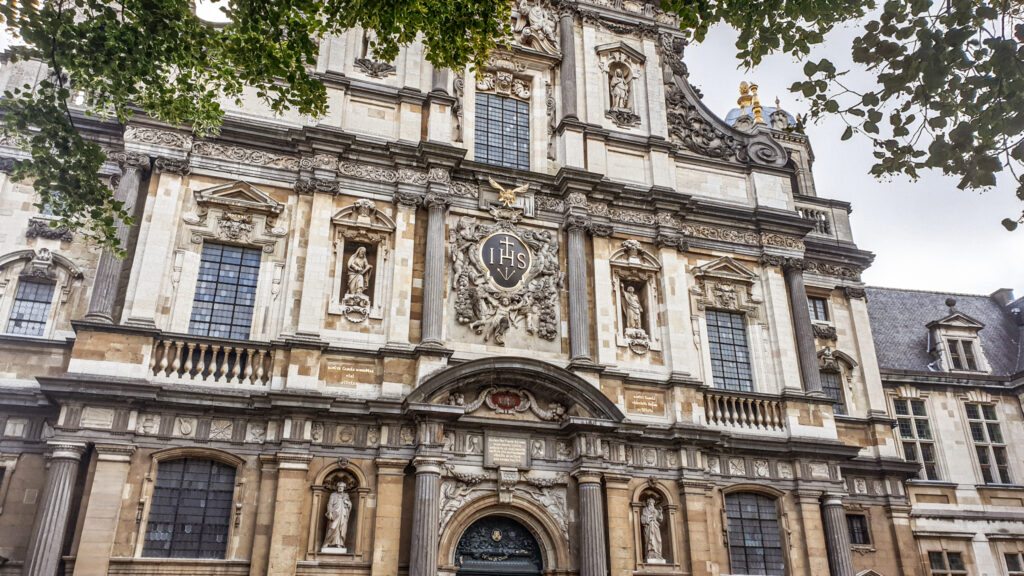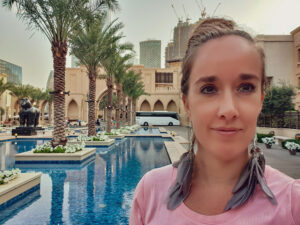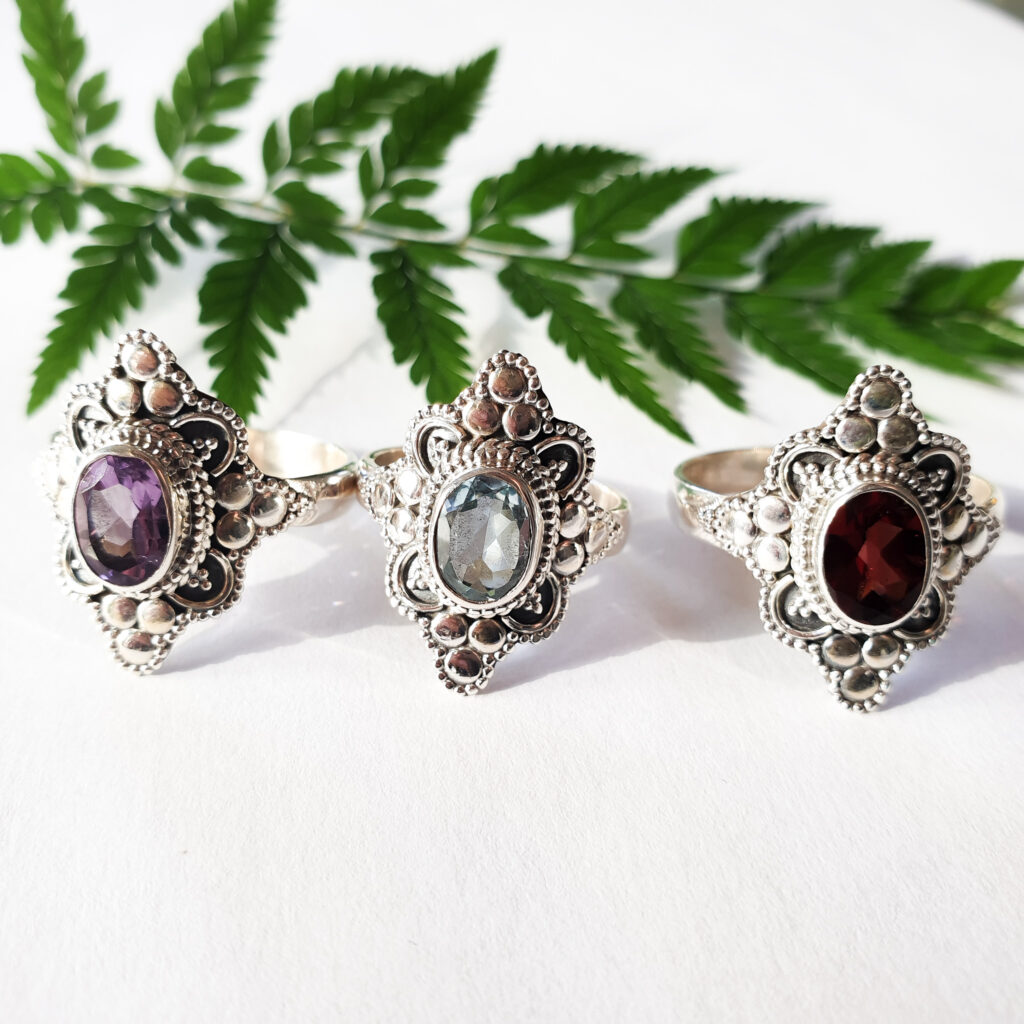The Sint-Carolus Borromeus (Saint Charles Borromeo) church is situated in the historical centre of Antwerp. The impressive baroque church is located at the iconic Hendrik Conscience square. The church was known as the Rubens church and is constructed in the 17th century. All of the ceiling paintings made by Rubens were destroyed. And other Ruben paintings were sold. Read more about the history of the church and explore the baroque architecture and interior.

Table of Contents
History
The original name in the 17th century was Sint-Ignatius church (Saint Ignatius). The church was constructed in 1626 and started as the Jesuit church of Antwerp. The Sint-Ignatius church was known for the Rubens paintings but most of them were destroyed in the 18th century or claimed by empress Maria-Theresia. The Jesuits were forced to leave Antwerp and the church was confiscated and reopened in 1779. They also renamed the church after Charles Borromeo (Mannaerts, 2011).
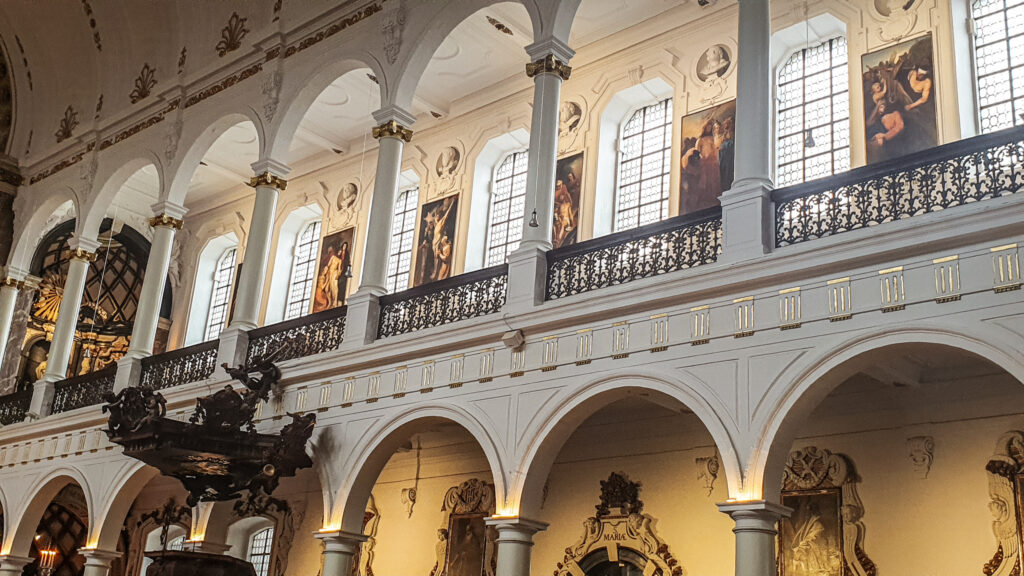
Façade architecture
The façade of the church is inspired by another church in Rome, the Gesù church. In the 16th century the façade was a modern example of the renaissance and baroque architecture. But the baroque architecture dominates the facades. The renaissance architecture has a horizontal structure and is static. A great example is the City Hall in Antwerp. The baroque architecture is dominated by decorative elements. The façade of the Sint-Carolus Borromeus church has many of these elements such as: classical Greek columns, (the Doric, Ionic and Corinthian columns, cartouches, garlands, shells, fruit baskets, sculptures of angels, faces, masks and more.
An interesting fact is that the façade is 8 meters higher than the church itself. They wanted to impress everyone with a large and iconic landmark. The Sint-Carolus Borromeus church is a perfect example of the counter-reformation in Antwerp. The Catholic church tried to use the scale and splendour to reunite and commit the population towards the church.
In the centre of the façade is an insignia and it is designed by Rubens. In the middle of the insignia are three golden letters IHS. The letters IHS (or IHC) are a common Christian monogram symbolizing Jesus Christ. In Greek, the letters IHS stand for the first three letters of the name Jesus. In medieval times in Western Europe Latin was the common written language. The Latin version of IHS is Jesus Hominum Salvator. The Latin-alphabet letters were not systematically distinguished until the 17th century. So IHS, IHC and JHS, JHC are equivalent.
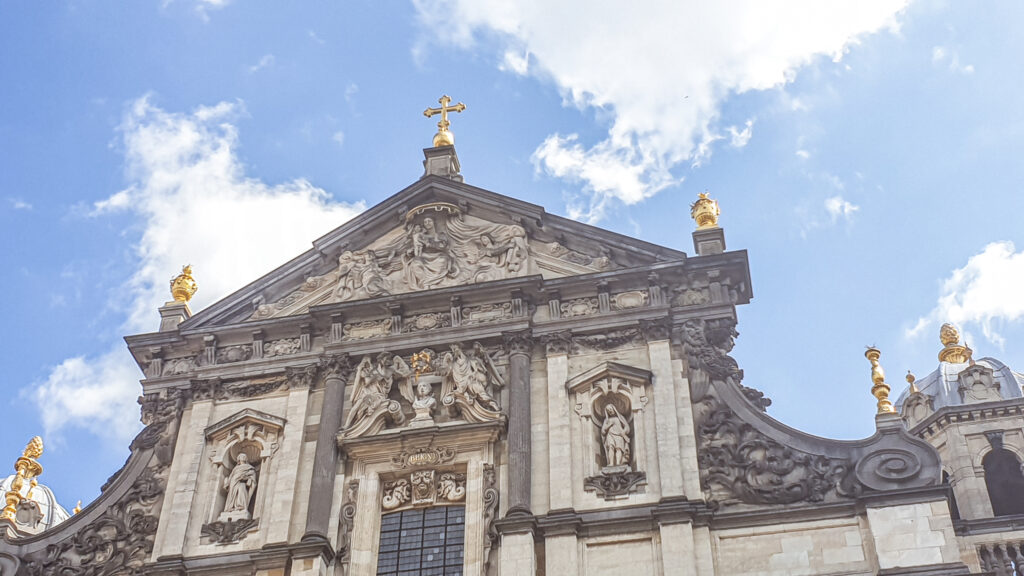
Rubens
There used to be 39 ceiling paintings made by Rubens. The art works are destroyed after lightning struck the church and caused a fire in 1718. The ceiling paintings were designed by Rubens but the actual was done by his pupils. One of them also became a famous painter, Anthony van Dyck. Besides the ceiling paintings Rubens also made two altar pieces. There is one painting of Rubens at the Sint-Carolus Borromeus church at the chapel on the right side of the high altar. See left picture below.
The tower
Most people in the Middles Ages did not have a clock or watch. To start Mass (the central act of worship of the Roman Catholic church) on time, most churches had bells. The bronze bells had to be placed somewhere high up so the sound was strong enough for people to hear. The tower of the Sint-Carolus Borromeus is 58 meters high. The tower disappears into the cityscape due to surrounding buildings.
The baroque architecture of the tower is restored in 2006 but still fragile and visitors are not allowed. To admire the tower it’s best to go to the corner of Kipdorp and Minderbroedersrui and look towards the Sint-Katelijnevest.
Interior
Gothic churches were designed with a Latin-cross shaped floor plan and often facing east. The baroque architecture of the Sint-Carolus Borromeus church is not focused on the cross shaped floor plan anymore. That the Sint-Carolus Borromeus is facing east is more a coincidence. Gothic churches, like the Sint-Andries church, designed coloured stained glass windows for the divine light to come in. The baroque churches prefer splendour and a celestial dimension inside the church. This is why the church looks more like a ball room rather than a church. Before the fire destroyed Rubens paintings the interior was even more detailed and colourful. The ceiling paintings of Rubens were originally at the side aisles.
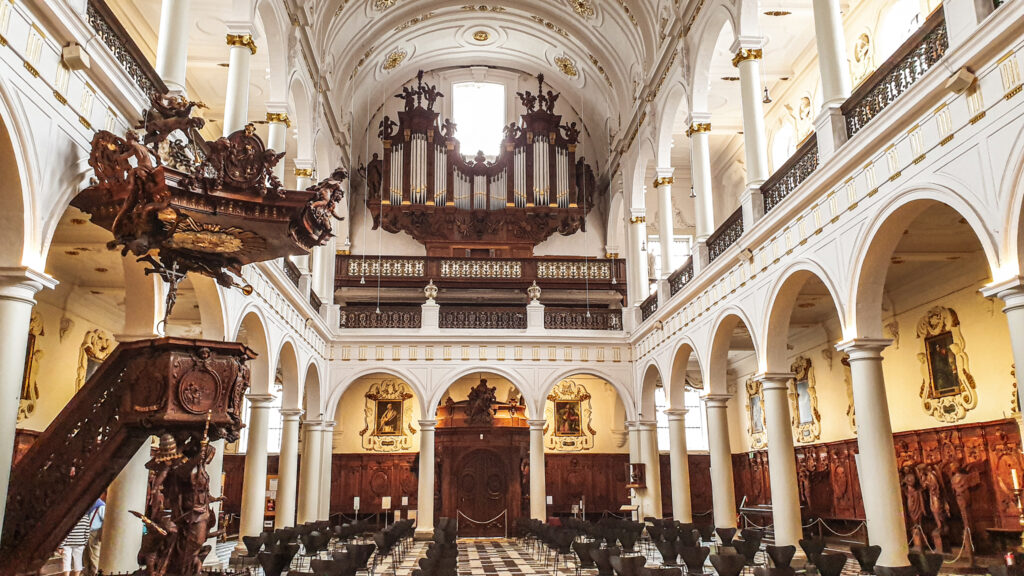
High altar
The high altar is the eye-catcher of the Sint-Carolus Borromeus church in Antwerp. The Jesuits realized that if you stare at the same image each week you don’t pay any attention to it. In the 27th century the Jesuits designed an unique system to change the painting a few times per year. Behind the high altar is a sort of closet constructed with five deep slots to store five paintings. Two of the original paintings were made by Rubens but were confiscated by empress Maria-Theresia and can be admired at the Kunsthistorisches Museum in Vienna. They still change the paintings three times per year. Check the website of Kerknet to check the dates. Follow this direct link to the website of Kerknet to see when they change the paintings (Schilderijwissel). It’s only available in Dutch but the dates are easy to translate to English.
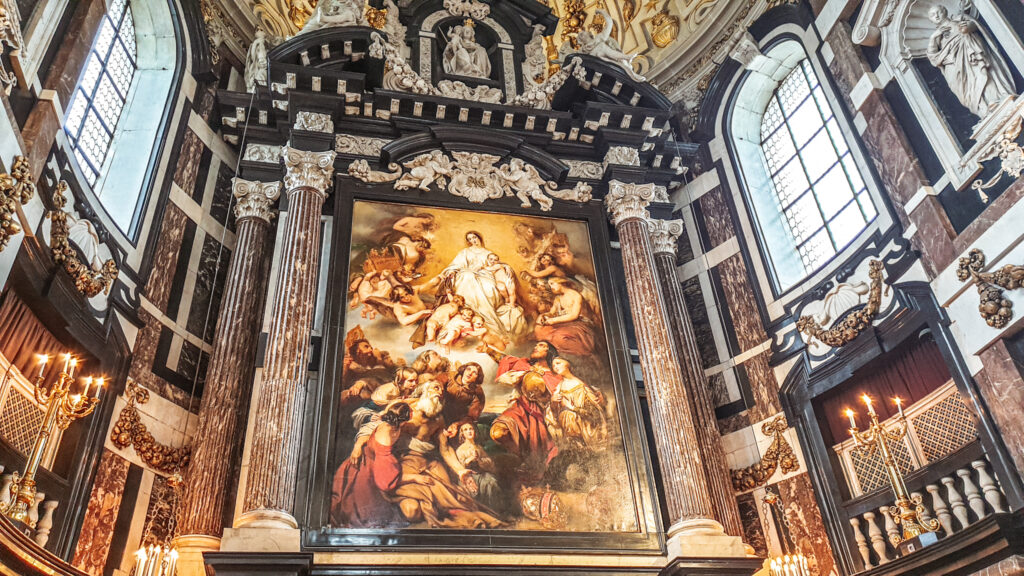
Pulpit
In the medieval times the pulpit was used to preach. Most people could not read or write and speeches in the church were a way to deliver a message. The Sint-Andries church has an impressive wooden pulpit. The wooden pulpit at the Sint-Carolus Borromeus church is a bit smaller but also designed with an eye for detail. The pulpit is constructed in 1720, a few years after the fire.
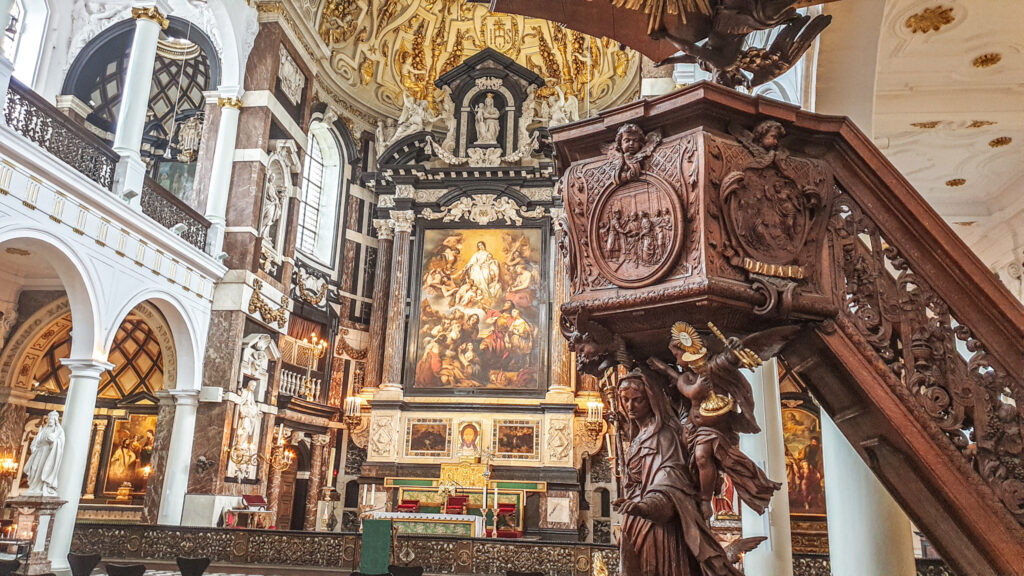
Confessional
A confessional is an enclosed stall in a church. The stall has two seats and is often divided by a screen or curtain. The priests sits in the stall to listen to the confessions of the people. Catholics used the confession to ask for forgiveness in the name of Christ. To guarantee the confessions can be done in private the Council of Trent (1545-1563) creates a new piece of church furniture, the confessional. The Sint-Carolus Borromeus church used to have 10 confessionals but only 8 remain of which 6 are the original. The wooden confessionals are designed with angels and medallions with figures of Mary, Petrus and other traditional characters.
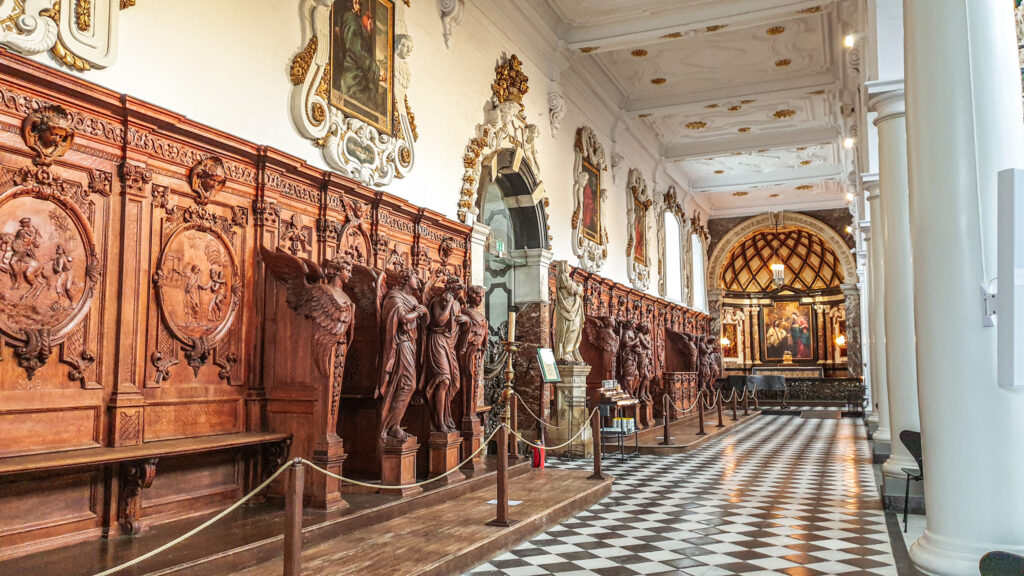
Chapel of Mary
The chapel of Mary is situated on the south (right) side of the church. It is a perfect example of baroque interior architecture. The chapel of Mary was not destroyed by the fire of 1718. There are many decorative elements, such as garlands, masks, flowers, shells, cartouches and angels on the ceiling. The painting at the altar is a copy of the original Rubens painting. In 1776 empress Maria-Theresia bought the painting and is now at the Kunsthistorisches Museum in Vienna.
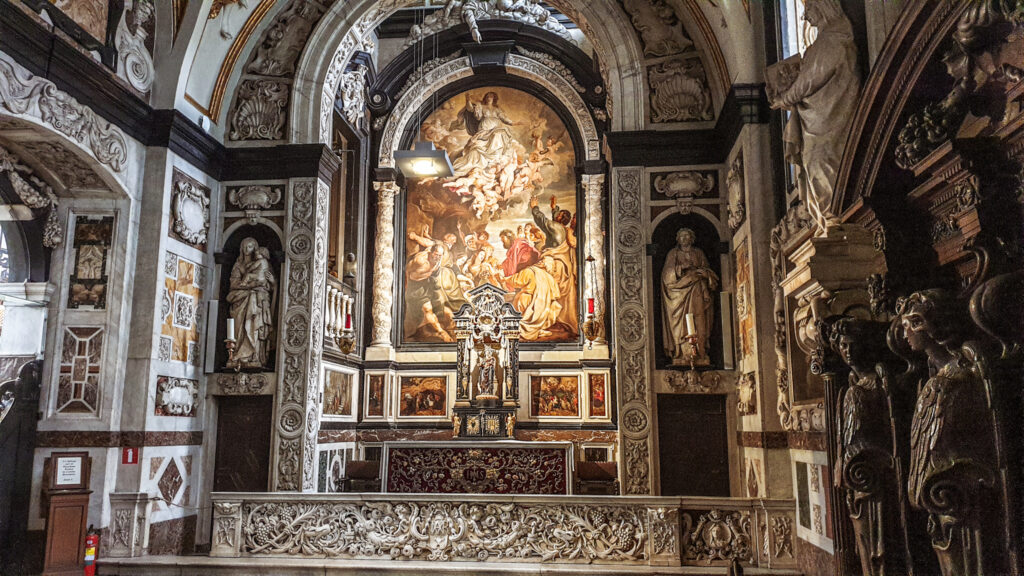
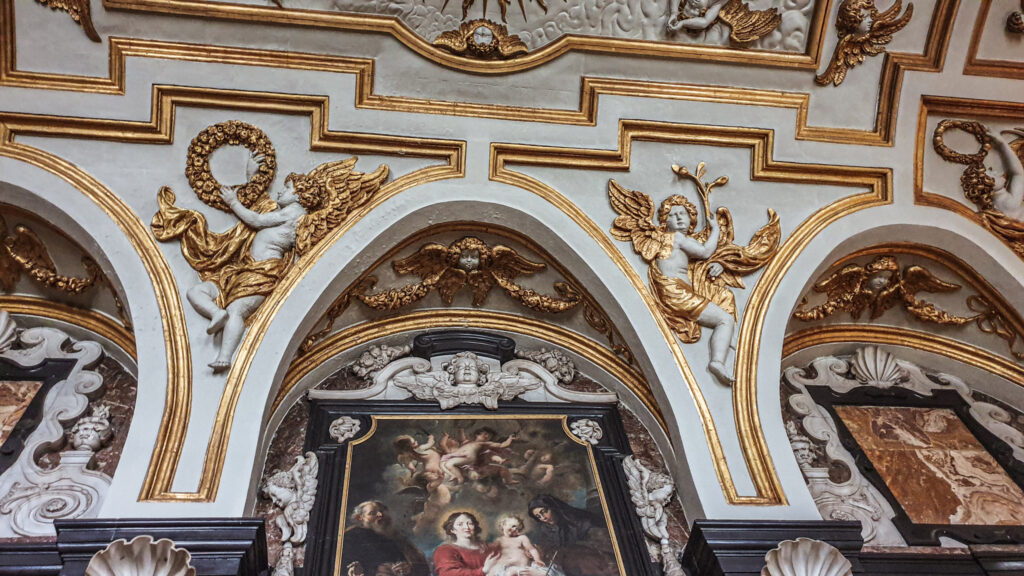
Sint-Ignatius chapel
The church is devoted to Sint-Ignatius (Saint Ignatius), hence the first name of the church (see second paragraph). The most prominent painting, Sint-Ignatius, is not always displayed because of the change of paintings. The Jesuits wanted an extra chapel for their beloved Sint-Ignatius. The chapel is quite soberly decorated, especially when you compare it to the Chapel of Mary. The Jesuits spend too much money and were forced to economize so they hadn’t the opportunity to decorate the Sint-Ignatius chapel like the Chapel of Mary. The chapel is now used as a quit room and for meditation.
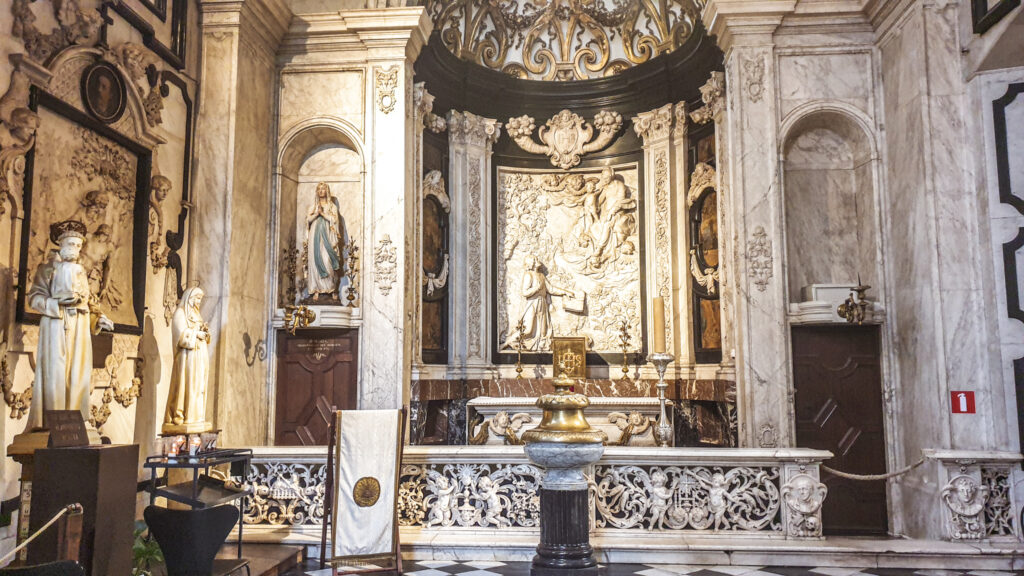
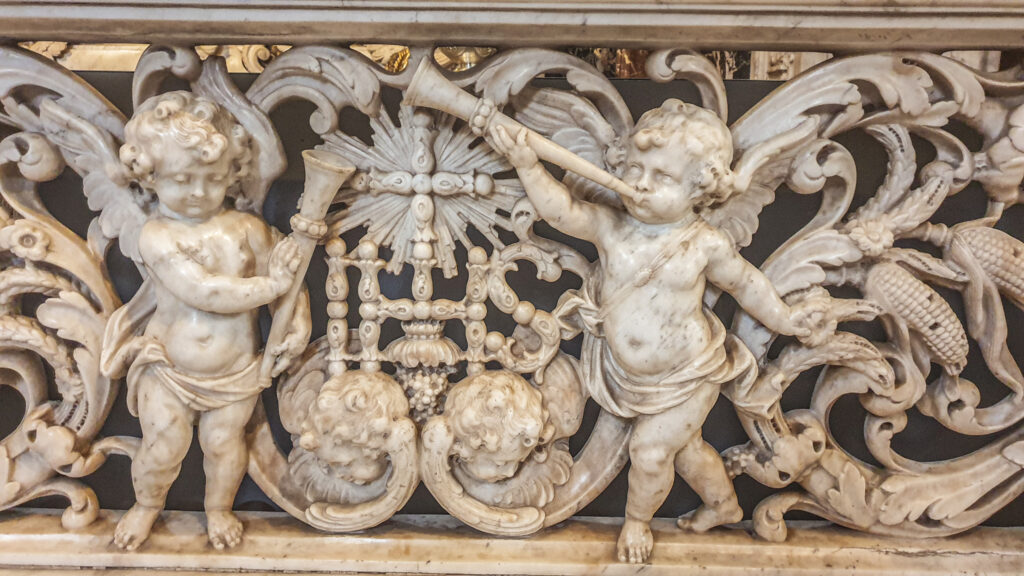
Catacombs
Most people don’t know the Sint-Carolus Borromeus has a catacomb. Neither did I. The catacomb is not open to the public but it is interesting to know that around 500 people are buried here.
Visit Sint-Carolus Borromeus church
The Sint-Carolus Borromeus church is located in the historic city centre at the Hendrik Conscience square. The admission to visit the church is free. The church is open in the morning from 10-12pm and in the afternoon from 14-17pm.
Would you like to visit another monumental church, go to the Sint-Andries church in the fashion district of Antwerp, Sint-Andries. Or visit Antwerp’s iconic church, Onze-Lieve-Vrouwe Cathedral.
In The World’s Jungle – Travel Blog
Check out the monumental highlights in Antwerp or step into the world of the famous baroque painter Pieter Paul Rubens. Visit the Plantin-Moretus Museum and find out more about the printers family. Discover how eight generations lived and worked in their private house, courtyard and ateliers. In de same street as the Maagdenhuis museum, de Lange Gasthuisstraat, is another museum: Mayer van den Bergh Museum. He was a private art collector and his entire collection has more than 3000 objects. Another article about Antwerp is about historical and unique theatres and cinemas in Antwerp.
Bibliography
Mannaerts, R. (2011). Sint-Carolus Borromeus: de Antwerpse jezuitenkerk, een openbaring. Toerismepastoraal Antwerpen.
